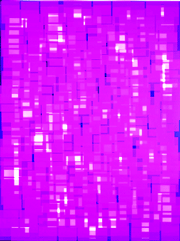Marc-Antoine Dupont’s abstract photograms introduce meditative quality to a cool medium
Marc-Antoine Dupont’s abstract photograms, all dating from 2004 and 2005, pack loads of bold color and graphic snap. With their jazzy geometry of layers and transparencies, soft and crisp edges, they exude a hybrid Mondrian-Photoshop aesthetic.
To be sure, however, these works are not computer-generated. Each is a unique C-print. Some of the prints are monochrome; several are multicolored. Dupont favors bright, highly saturated hues of turquoise, cyan, magenta, red, bright yellows, plus black and paper white. From this artificial-looking palette, all the life-like tones of color photographs are mixed.
Straight up in the photograms, these dyes are as basic to Dupont’s method and process as the primary colors of red, yellow and blue were to Mondrian’s signature paintings. Measuring up to 30 by 40 inches, each print is untitled and mounted on a precise aluminum panel. This presentation contributes to the work’s stylish mien. If there is an edginess to these yummy photographs, it’s their flirtation with industrial chic.
In fact, the French-born, New York-based artist had established a thriving career as an event designer before he became an artist. Dupont has been working in the photographic medium since 2001. Photogram technique involves direct manipulation of photographic materials without a camera or negatives. Dupont creates his effect the same way that Man Ray and Laszlo Moholy-Nagy made theirs in the 1920s and 1930s––by placing things on the surface of photo-sensitive paper in the darkroom, then exposing the arrangement to the enlarger’s light.
Contemporary artists such as James Welling and Adam Fuss have made significant bodies of work with C-print photograms, updating this trusty old avant garde deconstruction of photographic representation in the color medium. Dupont contributes to the dialogue in an interesting way. His innovation lies in renouncing the 3-D object’s traditional role in the photogram, instead working with flat little squares of colored plastic gel that mimic the negative’s small size and transparency. Man Ray used, for example, egg beaters or tin cones on gelatin silver paper. Welling used flowers in his 2005 exhibition in Chelsea. Fuss’ photograms of bathing babies introduced live subject matter.

Dupont has also brought out a gently meditative aspect in his technique. He must spend hours on each unique print, placing hundreds of gel fragments upon the paper. After the composition is finished and the paper exposed, their ephemeral pattern is lost forever when the print is developed. Paler tones result when the tiny gels overlap and stack up, blocking the light that reaches the paper.
Because some are pressed tight against the surface while others are not, a variety of hard and soft edges play off of each other. Dupont’s patient, bare-bones approach yields photographic prints that are perceptually rich and conceptually concise. At a time when so much contemporary color photography forces extra layers of artifice onto a medium immersed by nature in fantasy, it’s refreshing to see work of such immediacy and access. These photograms attest to the hand’s industry and the mind’s attention as applied to the chilly, art-industrial genre of color photography.
gaycitynews.com



































